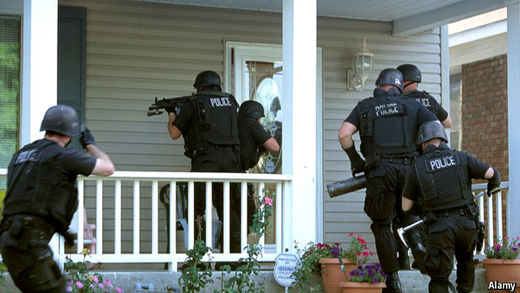
© unknown
The militarization of America's police is well documented. Hundreds of articles, books, and studies have been published in recent years showing that local police departments are increasingly using tactics and equipment formally reserved for the military.
"Billions of dollars' worth of military weapons and equipment is available to local police departments through grant programs administered by federal agencies such as the Departments of Defense, Justice, and Homeland Security," the American Civil Liberties Union writes on their page discussing police militarization.
Between 1995-1997, the Pentagon distributed 3,800 M-16s, 2,185 M14s, 73 grenade launchers, and 112 armored personnel carriers to local police departments across the country.Among the eye-opening changes in the tactics used by American police departments is the sharply increasing number of SWAT team raids being executed across the country. Let's take a look at statistics for one form of a raid known as the "no knock warrant" raid.
A "no knock warrant" gives a law enforcement agency the right to raid a citizen's house without knocking or identifying themselves first. The warrant is given under the assumption that the evidence hoping to be discovered in the raid could be destroyed by someone as police wait outside after knocking.
While the warrant seems to serve a legitimate purpose, statistics show police departments are executing no knock raids at drastically increasing rates over the last 30 years.In 1981, for example, there were 3,000 no knock warrants executed in America. In 2005, just 24 years later, this
number skyrocketed to over 50,000 no knock raids.
In 2006, CATO Institute policy analyst Radley Balko published a paper entitled
Overkill: The Rise of Paramilitary Police Raids in America. In the paper, Balko speaks out on the dangers posed to civilians when police begin executing frequent, military-style house raids.
The raids, he says, "are needlessly subjecting nonviolent drug offenders, bystanders, and wrongly targeted civilians to the terror of having their homes invaded while they are sleeping, usually by teams of heavily armed paramilitary units dressed not as police officers but as soldiers.
"These raids bring unnecessary violence and provocation to nonviolent drug offenders, many of whom were guilty only of misdemeanors.
The raids terrorize innocents when police mistakenly target the wrong residence. And they have resulted in dozens of needless deaths and injuries, not only of drug offenders, but also of police officers, children, bystanders, and innocent suspects."Balko has hard numbers to backup these claims.
Since 1995, SWAT teams have botched 292 raids. A botched raid could be a raid where an innocent person is injured or killed, for example, or a raid where police enter the wrong house. Forty innocent people and 20 nonviolent offenders have been killed in raids since 1995.
These raid statistics, like all numbers about ramped up police forces in America, are especially troubling given the time spans they are occurring over. At the same time that police departments are becoming increasingly militarized, America's violent crime rates are dropping, suggesting that the increased police aggression is not necessary.
The trend has led people like Van Jones, director of the Ella Baker Center for Human Rights, to make
statements like the following:
"If this were happening in any other country in the world, this incredible militarization of the police, the incredible expansion of police power, the increase in police weaponry, the decrease in defendants' rights, the incredible stockpiling of bodies behind prison walls, we'd be screaming."
when they dropped the "A" from the name U.S.A. or shortened "The United States" to simply "the U.S." Changing the numerological value of the name came with decades of internal fighting for control over the superpower and reflects the arrogance of the paragovernment and military system that now controls what the public think is their real government. Removing the 'A(merica)' also demeans the earned respect that was once shining out for all the world to see. The country that once was is now popularly referred to worldwide as the U.S. This curt name reflects the paragovernments' demand for respect.
Anyway… that's how I see it.